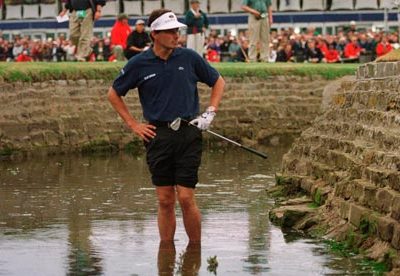By Ed Travis
According to the recently released USGA and The R&A Distance Insights Report (DIR) golfers, including you, hit the ball too far and future distance increases must be stopped by “rolling back” equipment performance.
The DIR effectively draws a line in the sand, but did not say what would be changed, or if anything would be done. The implication seems clear, however.
Quoting from the Report’s conclusion:
“This report clearly shows a consistent increase in hitting distance and golf course lengths over the last 100-plus years. These increases have had a profound impact on costs to build, modify and operate golf courses and they have impacted golfers at all levels. We believe this problem will continue unless this cycle is brought to an end. With collaboration from the entire golf community, we have an opportunity to stem this tide and help ensure golf remains sustainable and enjoyable for generations to come.”
“Brought to an end” and “stem this tide” sound like a prelude to reversing allowable performance of clubs and balls to some previous level. 
The Report also says more study and additional input from “stakeholders” is needed pushing the inevitable out at least a year. If you have any doubt as to the outcome, Mike Davis, Chief Executive Officer of the USGA, went on record two years ago saying before his term of office ends, he will get the ball “rolled back.”
Neither does it seem there is much room for compromise other than arguing over how many yards will be pared. It’s baffling rules makers want to keep golfers from hitting the ball farther, in effect making the game harder, while at the same time professing their desire to “grow the game.”
The reasoning of this apparent dichotomy is not apparent. It does seem though golf’s traditions are being skewed to overwhelm common sense and rationalize the idea tee balls ought to go less distance.
The history of golf is filled with technological advancements the rubbery ball, sand wedges, the wound ball, steel shafts and metal driver heads just to name a few. The current solid core ball and high rebound clubfaces were merely the next step. Will future technological advancement for Golf come to an end, or be discouraged?
The DIR admits average golfers may not be the problem noting driving distance last year for the average male recreational player was essentially unchanged from 2005. Thus, golfers hitting it too far are the professionals and elite amateurs. These are the bigger, stronger, faster athletes smashing the ball unimaginable distances. They have the physical attributes, training and ability to take maximum advantage of the low-spin solid core balls and clubs with the trampoline face.
This DIR seems to ignore several basic facts. Frank Thomas, inventor of the graphite shaft and former Technical Director of the USGA puts it succinctly,
“Fortunately, the laws of nature are playing an important part in governing the distance the ball will travel, while the athleticism of the elite golfers – about 0.1% of the golfing population– has changed, as it has in all other sports. Unfortunately — for most of us – this has not been as significant a change.”
This is analogous to the argument more length and more resources are necessary to contain the longer hitting elite golfers, a situation which has already been resolved for virtually all the layouts used for top-level tournaments. The Golf Channel’s Brandel Chamblee tweeted after the Genesis Invitational,
“Riviera proved this week, just as Merion did at the US Open in 2013, that courses designed in the golden age of architecture are not made obsolete by today’s equipment. Firm conditions and green speeds that allow the use of interesting contours is all that is needed. And trees.”
Courses may be closing because of too few players, but none have locked the doors due to too few yards and certainly no players are leaving the game because they hit the ball too far making the game is too easy.
New layouts and renovations, few of which will ever hold an event for the elites, may simply have fallen for the developer/architect ego-boosting testosterone-laden “my course is longer than your course.”
For years the USGA and the R&A have been warning that golf has a distance problem and it would be naïve to believe the DIR wasn’t compiled with “we’ve got to do something about this” in mind. A reasonable guess would be the Rules will be changed to rein in distance by limiting club responsiveness, or ball speed, and possibly both.
Since most weekend warriors feel pretty good if they can produce a tee shot that travels in excess of 200 yards, the obvious solution is two sets of rules, or bifurcation. One set of rules for us mere mortals and another for the elites. The USGA has long-held, however, that bifurcation of the Rules is unacceptable.
Faced with solving the supposed distance problem and without splitting the rules based on playing ability the most probable solution is a local rule allowing events such as the U.S. Open to specify a lower amount of clubface rebound, or a shorter ball.
The idea that golf equipment companies, that have spent millions of dollars creating modern golf balls and clubs, would put themselves in the position of being penalized for doing too good a job is irrational.
Tour player validation is a key factor in every golf equipment manufacturer’s marketing plan. The implied premise being, with the latest and greatest club, ball, shoe, glove, etc. every weekend warrior can rip it like Rory, D.J., Brooks or Bryson. A bit irrational, but that’s the basic sizzle in the golf equipment message. Two sets of equipment standards would certainly muffle and possibly silence tour player validation from manufacturer’s product promotion.
Finally, chances are close to zero the club and ball makers will take this lying down. Could a manufacturer sue the USGA? Have we forgotten the PING lawsuit 20 years ago? Will that make golf’s ruling body reluctant to the fight a prolonged and expensive legal battle?
One thing is sure, the Distance Insights Report increases the drumbeat for change. For golf equipment, it’s all over but the shouting.










